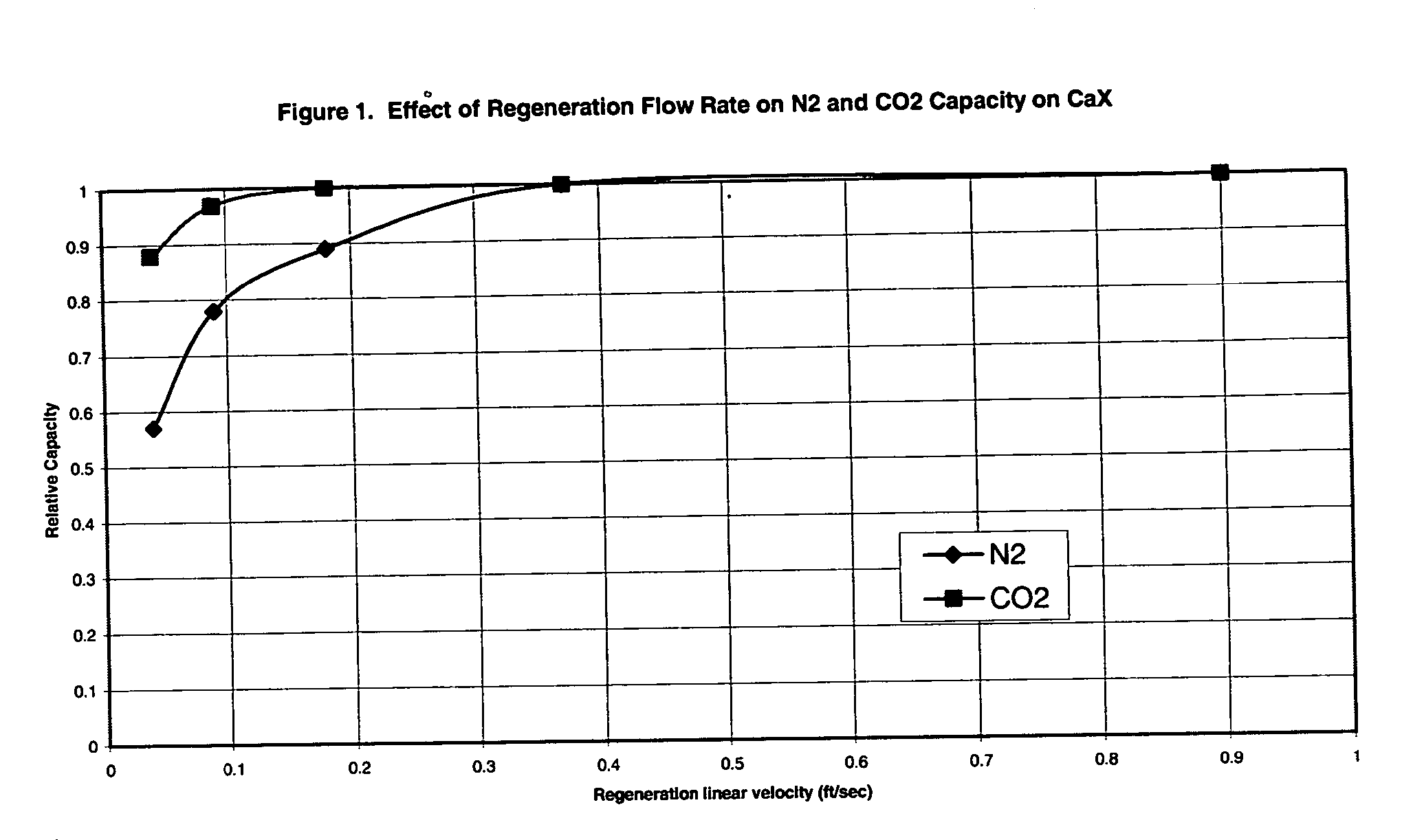Periodic high temperature regeneration of thermal swing adsorption systems
a high temperature regeneration and adsorption technology, applied in the field of periodic high temperature regeneration of thermal swing adsorption systems, can solve the problems of water adversely affecting the capacity of the adsorbent to adsorb contaminants, and water ingress into the adsorbent remains a problem in the tsa system
- Summary
- Abstract
- Description
- Claims
- Application Information
AI Technical Summary
Benefits of technology
Problems solved by technology
Method used
Image
Examples
example 1
[0027] NaX zeolite is widely used to remove trace CO2 from air prior to the cryogenic distillation of the air into its constituent components. The typical as-received water loading for a commercial grade NaX zeolite is 1.5 wt %. Table 1 below gives the residual water content (determined by weight loss at 600° C.) for a commercial grade NaX zeolite as a function of regeneration temperature. The table also gives the relative equilibrium CO2 capacity determined by breakthrough from air (100 psig, 25° C., 400 ppm CO2 in air).
TABLE 1Regeneration T (° C.)Residual water (wt %)Relative CO2 capacity4000.41.03001.20.782001.60.62
[0028] Typically, it is desired to operate TSA systems at a regeneration temperature as low as possible. This is to reduce the power requirements of the system. A typical TSA regeneration temperature is 200° C. As shown in Table 1, regeneration of the NaX zeolite at 200° C. reduces the residual water content of the zeolite to 1.6 wt %, which is essentially the as-rec...
example 2
[0029] Example 1 was repeated for a commercially available CaX zeolite (often used for the removal of N2O from ambient air). Since CaX adsorbs water more strongly than NaX, its performance is even more drastically affected by high regeneration temperature.
TABLE 2Regeneration T (° C.)Residual water (wt %)Relative CO2 capacity4000.71.03001.40.712002.50.51
[0030] At a regeneration temperature of 200° C., CaX has significantly more water loading than as-received material. Therefore, if a plant upset occurs on a plant with a 200° C. regeneration system, the system will not recover its initial CO2 capacity. If regeneration at 300° C. is carried out, the CO2 capacity increases 39% (0.71 / 0.51). At 400° C. regeneration, the CO2 capacity increases 96% (1.0 / 0.51). Again, these large capacity increases can be realized with only one high temperature regeneration.
[0031] The skilled practitioner will appreciate that zeolite adsorbents are susceptible to hydrothermal steaming and loss of capacity...
example 3
[0032] In this example, a commercial grade CaX zeolite was regenerated at 400° C. under various flow rates of nitrogen. After regeneration was complete (16 hours), the samples were cooled down and nitrogen adsorption isotherms were measured at 30° C. The results obtained are given in Table 3.
TABLE 3(ft / sec)(sec)Linear regen flow rateRegeneration contact timeRelative N2 capacity0.900.741.00.371.81.00.183.70.890.0897.50.810.03917.30.57
[0033] The relative N2 capacity is defined as the ratio of the Henry's law constant (initial isotherm slope) at the given flow rate divided by the Henry's law constant obtained at the highest linear regeneration velocity. The results in Table 3 show that at high linear regeneration flow rates (short contact times), high N2 capacities are obtained. However, as the regeneration linear velocity goes below 0.37 ft / sec (regeneration contact time of 1.8), the N2 capacity is reduced. This shows that if optimal N2 capacities of CaX are desired, regeneration fl...
PUM
| Property | Measurement | Unit |
|---|---|---|
| linear velocity | aaaaa | aaaaa |
| temperature | aaaaa | aaaaa |
| temperatures | aaaaa | aaaaa |
Abstract
Description
Claims
Application Information
 Login to View More
Login to View More - R&D
- Intellectual Property
- Life Sciences
- Materials
- Tech Scout
- Unparalleled Data Quality
- Higher Quality Content
- 60% Fewer Hallucinations
Browse by: Latest US Patents, China's latest patents, Technical Efficacy Thesaurus, Application Domain, Technology Topic, Popular Technical Reports.
© 2025 PatSnap. All rights reserved.Legal|Privacy policy|Modern Slavery Act Transparency Statement|Sitemap|About US| Contact US: help@patsnap.com

